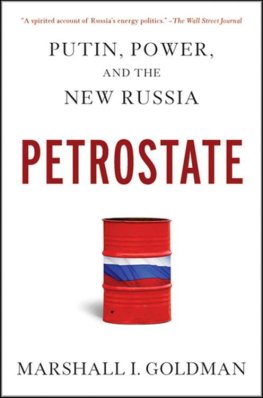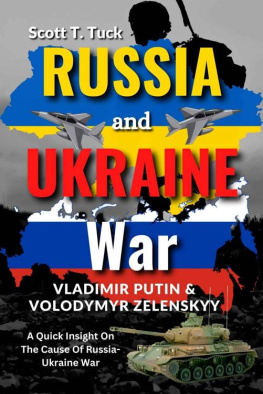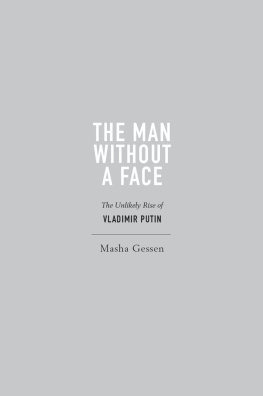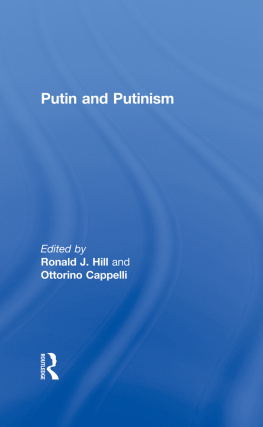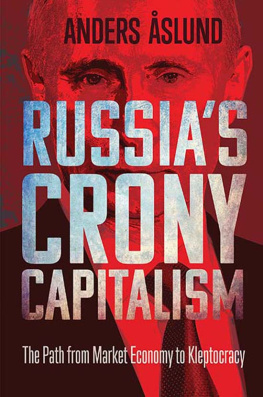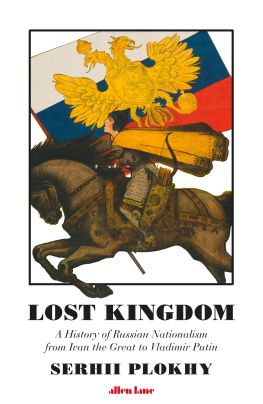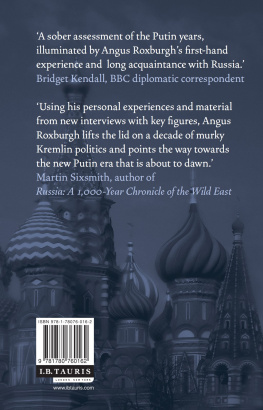Vladimir Putin and Russias Imperial Revival
Vladimir Putin and Russias Imperial Revival
David E. McNabb
First published 2016 by Routledge
2 Park Square, Milton Park, Abingdon, Oxfordshire OX14 4RN
52 Vanderbilt Avenue, New York, NY 10017
Routledge is an imprint of the Taylor & Francis Group, an informa business
First issued in hardback 2019
Copyright 2016 Taylor & Francis
All rights reserved. No part of this book may be reprinted or reproduced or utilised in any form or by any electronic, mechanical, or other means, now known or hereafter invented, including photocopying and recording, or in any information storage or retrieval system, without permission in writing from the publishers.
Notice:
Product or corporate names may be trademarks or registered trademarks, and are used only for identification and explanation without intent to infringe.
International Standard Book Number-13: 978-1-4987-1198-2 (Hardback)
This book is dedicated to Dr. Gundar J. King, professor and dean emeritus of the Pacific Lutheran University School of Business and founding president of the Association for the Advancement of Baltic Studies.
Contents
AC Atlantic Council (1996)
APEC Asia-Pacific Economic Cooperation (1998)
CBSS Council of Baltic Sea States (1992)
CCD COE Cooperative Cyber Defense Centre of Excellence (NATO) (2008)
CC (C2) Military command-and-control systems (n/a)
CES Common Economic Space (2006)
CFI Connected Forces Initiative (NATO) (2014)
CICA Conference on Interaction and Confidence-Building Measures in Asia (1999)
CIS Commonwealth of Independent States (1991)
CMEA Council of Mutual Economic Assistance (1949)
CRDFCA Collective Rapid Deployment Force for Central Asia (2001)
CSCE Helsinki Conference on Security and Cooperation in Europe (1995)
CSTO Collective Security Treaty Organization (2003)
CURBK Russia, Belarus, Kazakhstan Customs Union (2009)
EAS East Asian Summit (2011)
EDB Eurasian Development Bank (2006)
EEAF East European Allied Forces (1999)
EIA Energy Information Administration (US) (1977)
ESPA Eastern Siberia-Pacific Ocean Oil Pipeline (2nd stage) (2012)
EurAsEC Eurasian Economic Community (2000)
FA Federal Assembly (Parliament of Russia) (2000)
FEFD Far Eastern Federal District (2000)
NAC National Anti-Terrorism Committee (2006)
NATO North Atlantic Treaty Organization (1949)
NORC National Opinion Research Center (1941)
NRC NATO-Russia Council (2002)
NRF NATO Response Force (2013)
OPEC Organization of Oil-Exporting Countries (I960)
OSCE Organization for Security and Cooperation in Europe (1975)
PCC Political Consultative Committee (first formed in Poland) (1940)
RA Resettlement Administration (1896)
RF Russian Federation (1991)
RFE Radio Free Europe (US) (1949)
SCO Shanghai Cooperation Organization (2001)
SFD Siberian Federal District (2000)
SS South Stream (Black Sea gas pipeline) (2012)
WTO Warsaw Treaty Organization (1955)
This book is not only about the end of an empirewhat Strayer (2001, 376) called that grand meta-narrative of world history, the fall of empires. But it is also about the early stages of the rebirth of another empireat least the first clumsy, roughshod steps in that process. In addition to this preface, this book includes 11 chapters that focus on one or more aspects of the historical and present empirical foreign policies followed in building the Russian Empire in the shapes that it has taken since it emerged out of what is today Ukraine.
In the chapters that follow, I address the antecedents of the Russian and Soviet Empires and the imperial rebirth emerging from the aggressive, expansionist foreign policy of Russian President Putin. Although Russia is a long way from reclaiming its position as one of two global superpowers, it is still a nuclear power with a long history of depending upon armed diplomacy to achieve its foreign policy objectives. Russia is slowly but surely reforming its armed forces to meet local threats even while it maintains a nuclear power, with it modernizing its military and coming to terms with the reality of the failure of its dependence upon an army of one-year conscripts. It has tested its nearly quarter-century focus on fighting a land army with massed armor and found it inappropriate in the new reality of small wars fought in its borderlands. Vestiges of the military doctrine of a first-strike rocket nuclear war remain among senior officers of the army and navy. Still, Russias new-found will to aggressively threaten its smaller neighbors and annex their territories has been enough to bring all but very few NATO countries to continue to increase their annual defense budgets.
The discussion is divided into four related parts. Section I, A Millennium of Empire Building, includes two chapters that introduce aspects of Russian foreign policy from the twelfth century to the dissolution of the Soviet Union. is an overview of the early progression through the four central manifestations as an empire.
Section II, Russias Post-Soviet Foreign Policy, includes three chapters dealing with the authors interpretation of the geopolitical and economic events that have shaped the Russian Federations foreign policy since 1991. examines several policy tools employed by the Romanov and Soviet Empires to grow and defend their imperial positions from the 1880s to roughly the 1950s. These include the use of internal colonization and deportation and the barrier-building defensive networks of the post-World War II foreign policy of the Soviet Union.
Section III, Russias Foreign Policy Weapons, contains three chapters that describe the tools that Russias leaders are using to achieve their twenty-first-century foreign policy goals. examines the examples of Russias use of its vast energy supplies and its power over captive markets for Russian oil and gas as weapons in the aggressive foreign policy that it employs toward nations that contest its bullying of its neighbors and former possessions.
Section IV, Russias Aggressive Foreign Policy in Action, brings the discussion from its elements and antecedents to two examples of Russias exercise of these and other weapons of aggressive foreign policy to achieve its will over smaller and weaker neighbors. , the final chapter in this book, summarizes the authors and other Russia watchers conceptions and interpretations of the shape and future direction of Putin-influenced foreign policy.
The author once again acknowledges the debt he owes to Dr. Gundar J. King, Latvian patriot and dean emeritus of the Pacific Lutheran University School of Business. Many thanks are also due to senior editor Lara Zoble and the editorial and production staff at CRC Press. Those highly supportive and talented people can never be thanked enough for their consistent support and guidance throughout the writing of this book and previous works. Finally, I convey my sincere gratitude to Pacific Lutheran University for their many years of support for this book and my previous academic endeavors.
A policy analysis of this type is overwhelmingly dependent upon the works of the many different researchers and policy analysts that have devoted themselves to the study of the Russian empires from their earliest beginnings. I have done my best to ensure that their contributions are recognized in the text and references. Any error of omission or commission is mine alone.




